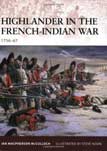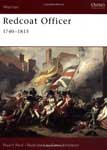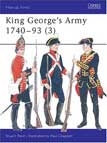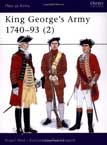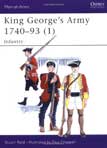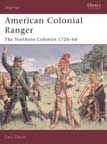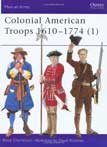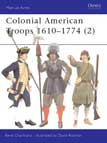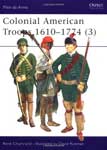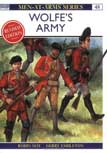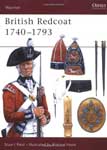

Colonial American historian Ian Macpherson McCulloch uses rare sources to bring to life the stirring story of the three Scottish Highland regiments that operated in North America during the French-Indian War (1754-1763). Forbidden to carry arms or wear the kilt unless they served the British King, many former Jacobite rebels joined the new Highland regiments raised in North America. Involved in some of the most bloody and desperate battles fought on the North American continent, Highlanders successfully transformed their image from enemies of the crown to Imperial heroes. The author pays particular attention to the part they played at Ticonderoga, Sillery, Bushy Run and on the Plains of Abraham, Quebec.
The commissioned officer ranks in the British Army from 1740-1815 were almost entirely composed of the affluent and educated - the sons of the landed gentry, the wealthy, and other professional people. This title looks at the enlistment, training, daily life and combat experiences of the typical British officer in the crucial periods of the North American conflicts, the American Revolution, and the Napoleonic Wars. It compliments the author's previous treatments in Warrior 19 British Redcoat 1740-93 and Warrior 20 British Redcoat (2) 1793-1815, which deal exclusively with the common infantryman, and balances these discussions through a look at the 'fellows in silk stockings'. Particular emphasis is placed on the experiences and activities in North America in the late 18th century.
The 18th century was marked by a steady growth in central control of the British Army and a corresponding decrease in the influence enjoyed by individual commanding officers. The most obvious sign of this process was the increasing uniformity of the clothing issued each year to the soldiers. Nevertheless, as far as those who devised the Clothing Regulations were concerned, it was a constant, and invariably quite uphill struggle to enforce compliance. This companion volume to Men-at-Arms 285 and Men-at-Arms 289 examines the organization and uniforms of King George’s cavalry and artillery together with those of the Board of Ordnance.
The 18th century was marked by a steady growth in central control of the British Army and a corresponding decrease in the influence enjoyed by individual commanding officers. The most obvious sign of this process was the increasing uniformity of the clothing issued each year to the soldiers. Nevertheless, as far as those who devised the Clothing Regulations were concerned, it was a constant, and invariably quite uphill struggle to enforce compliance. This companion volume to Men-at-Arms 285 takes a further look at the infantry uniforms of the mid-18th century British Army, also covering the various auxiliary infantry formations, such as the Militia, Volunteers, Marines and the troops of the East India Company.
To most contemporary politicians the 18th century British Army was no more than an unwelcome necessity in wartime and an unjustifiable extravagance in peacetime. Nevertheless, the overall impression which is to be gained from a close study of the Army's own records, and from the surviving letters, diaries and memoirs, is that the British Army of the 18th century was very little different in character or in spirit from today's British Army. It was, above all, a force which was led, not driven, into battle. This book looks at the uniforms and organisation of the infantry of King George's Army as well as its participation in various conflicts, such as the War of the Austrian Succession (1740-1748) and the Seven Years' War (1756-1763).
This title examines the development of the Colonial Rangers in this period, and shows how they were taught to survive in the woods, to fight hand-to-hand, to scalp a fallen foe, and to fight across all types of terrain and in all weather conditions. Based on previously unpublished source material, it paints a vivid picture of the life, appearance and experiences of an American colonial ranger in the northern colonies. Covering the battle at Lovewell's Pond in 1725, a watershed event in New England’s frontier history, through to King George's War (1740-1748), the rangers were prepared for the final imperial contest for control of North America, the French-Indian War (1754-1763).
From the earliest English settlements the survival of the infant colonies in North America depended upon local militias. Throughout the 17th and early 18th centuries the burden of successive wars with the American Indians, and with the regular troops and militias of Britain's colonial rivals France and Spain, fell mainly upon locally raised volunteers. This first of a fascinating three-part study includes a general introduction and chronology, and chapters on Crown troops in North America; and begins a colony-by-colony review of militias and provincial units. The text is illustrated with rare early images and with eight specially commissioned full colour plates.
From the earliest English settlements the survival of the infant colonies in North America depended upon local militias. Throughout the 17th and most of the 18th century royal troops were seldom shipped out from Britain, and the main burden of successive wars with the American Indians, and with the regular troops and militias of Britain's colonial rivals France and Spain, usually fell upon locally raised soldiers. These units also fought alongside the Crown forces during major operations such as the French-Indian War of the 1750s. This second of a fascinating three-part study covers the militias and provincial troops raised in Massachusetts, New Hampshire, Connecticut, Rhode Island, Maryland, New York and New Jersey.
From the earliest English settlements the survival of the infant colonies in North America depended upon local militias. Before the mid-18th century royal troops were seldom shipped out from Britain, and the main burden of successive wars with the American Indians, and with Britain's colonial rivals France and Spain, fell upon locally raised units, which also fought alongside the Crown forces during the major operations of the French-Indian War of the 1750s. This final book of a fascinating three-part study covers the militias and provincial troops raised in the Carolinas, Pennsylvania, Delaware, Georgia, Nova Scotia, Hudson's Bay and Quebec Province; and also Rangers, and colors and standards.
The British victory at Quebec in 1759 was a landmark in the history of North America. In this "year of miracles," according to Horace Walpole, one could "never afford to miss a single copy of a newspaper for fear of missing a British victory somewhere." Of all the pivotal figures in the Seven Years' War (1756-1763), a cast which included George Washington, Sir William Johnson, Lord Howe and Montcalm, Major-General Wolfe remains etched most deeply in Americans' memories for his heroic leadership at Quebec. Enhanced by illustrations and photographs, this book focuses on the British forces throughout their disastrous and triumphant wilderness campaigns which ultimately ensured the birth of the English-speaking United States of America.
During this period, the British army earned itself a formidable reputation as a fighting force. However, due to its role as a police force at home, and demonisation by American propaganda during the American Revolution (1763-1776), the army was viewed as little removed from a penal institution run by aristocratic dilettantes. This view, still held by many today, is challenged by Stuart Reid, who paints a picture of an increasingly professional force. This was an important time of change and improvement for the British Army, and British Redcoat 1740-1793 fully brings this out in its comprehensive examination of the lives, conditions and experiences of the late 18th-century infantryman
Pope Stefanus II arrives in Ponthion
Afonso IV succeeds Dionysius as King of Portugal
Calais, last English possession in France, retaken by French
Antonio "Michele" Ghislieri is elected Pope Pius V
Michaele Ghislieri is elected Pope Pius V
England signs an offensive and defensive alliance with Netherland
Last day of the Julian calendar in Bohemia and Holy Roman empire
Boris Godunov seizes Russian throne on death of Feodore I
Robert, Earl of Essex leads revolt in London against Queen Elizabeth
Fire destroys Jamestown, Virginia
Galileo discovers 1st 3 Jupiter satellites, Io, Europa and Ganymede
Francis Bacon becomes English lord chancellor
Germany and Transylvania sign Peace of Nikolsburg
Composer Pier Cavalli marries rich widow Maria Sosomeno
Fire after heavy storm destroys 2 / 3 of De Rijp Neth, 1 dies
Russian Czar Peter the Great departs Netherlands to England
Typewriter patented by Englishman Henry Mill (built years later)
Battle at Panipat India: Afghan army beats Mahratten
1st US commercial bank, Bank of North America, opens in Philadelphia
1st US seed business established by David Landreth, Philadelphia
1st balloon flight across English Channel (Blanchard & Jeffries)
2nd Bank of US opens
1st printing in Hawaii
Liberia colonized by Americans
1st US Railroad Station opens (Baltimore)
HMS Beagle anchors off Chonos Archipelago
Florida troops takeover Ft Marion at St. Augustine
Battle of Manassas Junction, Virginia
Romney Campaign-Stonewall Jackson march towards Romney, West Virginia
Arkansas constitutional convention meets in Little Rock
Mississippi constitutional convention meets in Jackson
Dutch King Willem II marries Emma von Waldeck-Pyrmont
Start of Sherlock Holmes adventure "Valley of Fear" (BG)
W B Purvis patents fountain pen
Mine explosion kills 100, Krebs, Okla-blacks trying to help rescue white survivors, driven away with guns
Hermann Sudermanns "Heimat, " premieres in Berlin
Motion picture experiment of comedian Fred Ott filmed sneezing
Fanny Farmer publishes her 1st cookbook
Start of Sherlock Holmes "Adventure of Blanched Soldier" (BG)
Marconi Co establishes "CQD" as 1st International radio distress signal
England beat Australia by one wicket at the MCG
Stanley Cup: Ottawa Senators sweep Galt (Ont) in 2 games
1st airplane bombing experiments with explosives, San Francisco
Dutch Scouts Organization established in Amsterdam
William M Burton patents a process to "crack" petroleum
1st steamboat passes through Panama Canal
German troops conquer Fort Vaux at Verdun
Baltimore Sun warns of Ku Klux Klan
Musical "Big Boy" with Al Jolson premieres in New York City
Coml transatlantic telephone service inaugurated between New York and London
Harlem Globetrotters play 1st game (Hinckley, Ill)
"Buck Rogers, " 1st sci-fi comic strip, premieres
"Tarzan, " one of the 1st adventure comic strips, 1st appears
1st telephone connection between Netherlands and East Indies
1st game played at Orchard Lake Curling Club, Michigan
1st edition of People and Fatherland published in the Netherlands
"Flash Gordon" comic strip (by Alex Raymond) debuts
Princess Juliana marries German Prince Bernhard von Lippe-Biesterfeld
Tennis champs Helen Moody and Howard Kinsley volley 2,001 times (1h18m)
WW II siege of Bataan starts
Air Force announces production of 1st US jet fighter, the Bell P-59
Lord Haw-Haw reports total German victory at Ardennen
Cambodia becomes autonomous state inside French Union
US President Truman raises taxes for Marshall-plan
1st photo of genes taken at University of Southern California by Pease and Baker
"Happy as Larry" closes at Coronet Theater NYC after 3 performances
Mental health wing of Mercy Hospital burns, kills 41 (Davenport Ia)
French Plevin government falls
President Truman announces development of hydrogen bomb
Marian Anderson becomes 1st black singer to perform at Met (NYC)
WCIQ TV channel 7 in Mt Cheaha, AL (PBS) begins broadcasting
Vinoo Mankad scores 231 vs. New Zealand, 413 opening stand with Roy
USSR shrinks army to 300,000
1st NFL Playoff Bowl (runner-up bowl) - Detroit beats Cleveland 17-16
Trucial States (now UAE) issue their 1st postage stamps
AFL Pro Bowl: West beats East 47-27
Assassination attempt on Indonesian President Sukarno, fails
Bollingen Prize for poetry awarded to John Hall Wheelock
1st class postage raised from 4 cents to 5 cents
Bahamas becomes self-governing
Dick Weber rolls highest bowling game in air (Boeing 707)
France announces it will convert $150 million of its currency to gold
Dance Theatre of Harlem debuts
Gene Kiniski beats Lou Thesz in St. Louis, to become NWA champ
"Newlywed Game" premieres on ABC TV
"GE College Bowl" quiz show premieres on NBC TV
1st class postage raised from 5 cents to 6 cents
US Congress doubles President salary
Farmers sue Max Yasgur for $35,000 in damages caused by "Woodstock"
LA Lakers chalk up 33rd consecutive win (NBA record)
Lewis F Powell Jr becomes a Supreme Court Justice
William Hubbs Rehnquist, sworn in as Supreme Court Justice
"Purlie" closes at Billy Rose Theater NYC after 14 performances
British Darts Organisation founded in North London
Johnny Watkins bowls six overs 0-21 vs. Pakistan Never again
US Poet James Merrill wins Bollingen Prize
WNPB TV channel 13 in Marquette, MI (PBS) begins broadcasting
Dutch rations gasoline
"Shenandoah" opens at Alvin Theater NYC for 1050 performances
Bollingen Prize for poetry awarded to AR Ammons (Sphere)
Led Zeppelin fans riot before Boston concert, causing $30,000 damage
Angola revises its constitution
Vietnamese forces capture Phnom Penh from Khmer Rouge
"Fame" premieres on NBC TV
Australia regain the Ashes with a 2-1 series win vs. England
Reagan ends US arms embargo against Guatemala
"King & I" opens at Broadway Theater NYC for 191 performances
KHQ-AM in Spokane WA changes call letters to KLSN (now KAQQ)
Chicago Bears defeat New England Patriots 46-10 in Super Bowl XX
Netherlands Bank issues 250 guilder notes
STS 61-C mission scrubbed at T -9m because of weather problems
US President Reagan proclaims economic sanctions against Libya
French airplanes harass Libyan positions in Duadi Doum
Kapil Dev takes his 300th Test wicket, at 28 the youngest
Akhito becomes Emperor of Japan
Cleveland Cavs block 21 New York Knick shots tying NBA regulation game record
International Conference on Limitation of Chemical Weapons opens in Paris
Lynn Jennings runs world record 5K indoor at 15:22.64
Tower Of Pisa closed to the public after leaning too far
"Nia Peeples Party Machine" premieres on TV
AT&T releases video-telephone ($1,499)
South Africa beat Australia in the Sydney Test by 5 runs
United Express commuter plane crashes in Ohio, killing 5
US female Figure Skating championship won by Tonya Harding
"Christmas Carol" closes at Richard Rodgers Theater NYC after 18 performances
"Passion" closes at Plymouth Theater NYC after 280 performances
"Crazy after You" closes at Shubert Theater NYC after 1622 performances
16th United Negro College Fund raises $12,600,000
Newt Gingrich, narrowly re-elected speaker of the House
